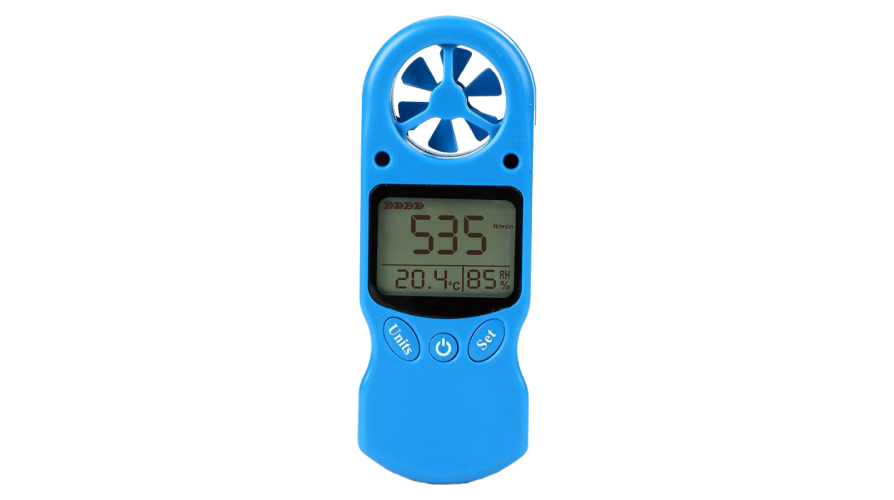Anemometer Innovations: The Most Up To Date Modern Technology for Wind Rate Measurement
Anemometer Innovations: The Most Up To Date Modern Technology for Wind Rate Measurement
Blog Article
All You Need to Understand About Anemometers: How They Function, Why They Matter, and Where to Make use of Them
Anemometers, though frequently forgotten in the world of clinical tools, play a vital duty in numerous fields, offering useful understandings into wind rate and air flow patterns. As we delve right into the complexities of anemometer technology, we will certainly reveal the inner operations of these devices, their significance, and the vital factors to consider when selecting the right anemometer for specific applications.

Anemometer Fundamentals
An important instrument used to gauge wind speed and instructions, the anemometer plays an essential function in weather forecasting and different industries. An anemometer typically consists of 3 or 4 mugs that turn in the wind, a vane that points into the wind, and sensors to track the rotations or motions.
There are various sorts of anemometers available, including mug anemometers, vane anemometers, hot-wire anemometers, and sonic anemometers, each with its distinct functions and applications. Mug anemometers are frequently used for standard wind speed dimensions, while vane anemometers are liked for directional measurements. Hot-wire anemometers appropriate for low airspeeds, and sonic anemometers are ideal for high-precision dimensions in research study and commercial settings. Recognizing the essentials of anemometers is necessary for exact wind data collection and evaluation across various sectors.
Concepts of Anemometer Operation
Building on the fundamental understanding of anemometer essentials, the concepts of anemometer procedure clarify the technicians behind wind speed and instructions measurements. Anemometers operate the concept of air movement affecting a sensor, triggering it to turn. Mug anemometers, as an example, have three or even more cups that catch the wind, creating them to rotate faster as the wind speed increases. The rotation rate is after that exchanged a wind rate dimension. Vane anemometers, on the other hand, make use of a tail or a probe that aligns itself with the wind instructions, offering a dimension of wind direction based upon the alignment of the sensor. Hot-wire anemometers rely upon a warmed cord that cools off as wind passes over it, with the rate of cooling down identifying the wind speed. Ultrasonic anemometers procedure wind rate and instructions by evaluating the moment it takes for ultrasonic signals to travel in between transducers. Recognizing these concepts is vital for trusted and exact wind measurements in various applications.
Significance of Anemometers
Anemometers play an essential function in determining wind rate and instructions, supplying vital information for weather forecasting, environment researches, ecological tracking, and aviation operations. Meteorologists rely on anemometers to collect accurate wind data, helping them comprehend weather condition patterns, anticipate tornados, and concern prompt cautions to the public. Wind ranch operators make use of anemometers to evaluate wind problems and take full advantage of electrical energy manufacturing from wind turbines.
Applications Throughout Numerous Industries
Applications of anemometers extend throughout varied sectors, showcasing their versatility and energy past meteorology. In the sustainable power market, anemometers play a vital duty in evaluating wind conditions for wind farm placements, guaranteeing optimal energy manufacturing. Industries like building and mining make use of anemometers to check wind rates, important for safety methods, specifically when operating at heights or in open-pit mines where strong winds can posture hazards. Anemometers are also integral in the aeronautics market, aiding pilots in comprehending airspeed and wind direction for risk-free take-offs and landings. The maritime industry advantages from anemometers for ship navigation, aiding sailors anticipate weather changes and readjust paths appropriately. In agriculture, anemometers aid farmers in handling crop splashing by supplying real-time data on wind speed to stay clear of drift. Anemometers find applications in A/c systems to optimize air movement and boost energy effectiveness in structures. The varied use situations of anemometers highlight Visit Your URL their importance throughout different industries, highlighting their indispensable function in enhancing functional safety and efficiency (anemometer).

Choosing the Right Anemometer for Your Requirements
For general purposes, a cup anemometer useful link is appropriate for gauging wind rate, while a vane anemometer supplies wind direction data. like it Hot-wire anemometers are suitable for low airspeed dimensions, and ultrasonic anemometers provide high accuracy and sturdiness.

Conclusion
In final thought, anemometers play a crucial duty in determining wind rate and direction throughout different industries. It is essential to take into consideration the importance of anemometers in order to make informed decisions when picking the most ideal gadget for determining wind problems.
There are different types of anemometers offered, consisting of mug anemometers, vane anemometers, hot-wire anemometers, and sonic anemometers, each with its distinct features and applications. Cup anemometers are commonly used for standard wind speed measurements, while vane anemometers are favored for directional dimensions. Hot-wire anemometers are suitable for reduced airspeeds, and sonic anemometers are excellent for high-precision dimensions in research study and industrial setups.Structure on the foundational understanding of anemometer essentials, the principles of anemometer operation illuminate the technicians behind wind rate and instructions measurements. For general purposes, a cup anemometer is suitable for gauging wind speed, while a vane anemometer gives wind instructions information.
Report this page